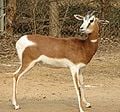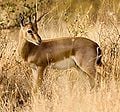Gazelle
| Gazelle | ||||||||||||||
|---|---|---|---|---|---|---|---|---|---|---|---|---|---|---|
| Thomson's Gazelle Thomson's Gazelle
| ||||||||||||||
| Scientific classification | ||||||||||||||
| ||||||||||||||
|
Several, see text |
- This article is about the antelope species. For other uses of the term, see Gazelle (disambiguation).
A gazelle is an antelope of the genus Gazella, although the three members of the genus Procapra also widely are referred to as gazelles. Gazelles are known as swift animals; they are able to reach high speeds (as high as 50 mph[1]) for long periods of time. Gazelles are mostly found in the grasslands and savannas of Africa, but they are also found in southwest Asia. They tend to live in herds and will eat less coarse, easily digestible plants and leaves.
The gazelle species are classified as part of the order Artiodactyla, family Bovidae and genus Gazella. Members of the Articodacycla order are principally distinguished by the foot; they have an even number of toes (the bovid family comprises 6 genera and 12 species). The taxonomy of the genus Gazella is a confused one, and the classification of species and subspecies has been an unsettled issue. Three species—the Red Gazelle, the Arabian Gazelle, and the Queen of Sheba's Gazelle—are extinct. All other gazelle species are listed as endangered, to varying degrees.
A recognizable example of the gazelle is Thomson's Gazelle (Gazella thomsonii), which is around 60 to 90 cm (23 to 35 inches) in height at the shoulder and is coloured brown and white with a distinguishing black stripe (as in the picture on the right). The males have long, often curved, horns. Tommies, as they are familiarly called, exhibit a distinctive behaviour of stotting (running slowly and jumping high before fleeing) when they are threatened by predators such as lions or cheetahs. This is a primary piece of evidence for the handicap principle advanced by Amotz Zahavi in the study of animal communication and behaviour.
Gallery
- Thompson's Gazelle.jpeg
Thomson's Gazelle
Species
- Subgenus Gazella
- Mountain Gazelle, G. gazella
- Speke's Gazelle, G. spekei
- Dorcas Gazelle, G. dorcas
- Saudi Gazelle, G. saudiya
- Chinkara, also known as Indian Gazelle, G. bennettii
- Subgenus Eudorcas
- Thomson's Gazelle, G. thomsonii
- Red-fronted Gazelle, G. rufifrons
- Subgenus Nanger
- Dama Gazelle, G. dama
- Grant's Gazelle, G. granti
- Soemmerring's Gazelle, G. soemmerringii
- Subgenus Trachelocele
- Cuvier's Gazelle, G. cuvieri
- Rhim Gazelle, G. leptoceros
- Goitered Gazelle, G. subgutturosa
Extinct
Fossils of genus Gazella are found in Pliocene and Pleistocene deposits of Eurasia and Africa. The tiny Gazella borbonica is one of the earliest European gazelles, characterized by its small size and short legs. Gazelles disappeared from Europe at the start of Ice Age, but they survived in Africa and Middle East. Three species become extinct in recent times due to human causes
Recent extinctions
- Subgenus Gazella
- Arabian Gazelle, G. arabica
- Queen of Sheba's Gazelle, G. bilkis
- Subgenus Eudorcas
- Red Gazelle, G. rufina
Prehistoric extinctions
- Gazella borbonica - European Gazelle
- Gazella thomasi' - Thomas's Gazelle
- Gazella praethomsoni
- Gazella negevensis
- Gazella triquetrucornis
- Gazella negevensis
- Gazella capricornis
- Gazella mytilinii
- Subgenus Vetagazella
- Gazella sinensis
- Gazella deperdita
- Gazella pilgrimi- Steppe Gazelle
- Gazella leile - Leile's Gazelle
- Gazella praegaudryi - Japanese Gazelle
- Gazella gaudryi
- Gazella paotehensis
- Gazella dorcadoides
- Gazella altidens
- Gazella mongolica - Mongolian Gazelle
- Gazella lydekkeri - Ice Age Gazelle
- Gazella blacki
- Gazella parasinensis
- Gazella kueitensis
- Gazella paragutturosa
- Subgenus Gazella
- Gazella janenschi
- Subgenus Trachelocele
- Gazella atlantica
- Gazella tingitana
- Subgenus Nanger
- Gazella vanhoepeni
- Subgenus Deprezia
- Gazella psolea
Credits
New World Encyclopedia writers and editors rewrote and completed the Wikipedia article in accordance with New World Encyclopedia standards. This article abides by terms of the Creative Commons CC-by-sa 3.0 License (CC-by-sa), which may be used and disseminated with proper attribution. Credit is due under the terms of this license that can reference both the New World Encyclopedia contributors and the selfless volunteer contributors of the Wikimedia Foundation. To cite this article click here for a list of acceptable citing formats.The history of earlier contributions by wikipedians is accessible to researchers here:
The history of this article since it was imported to New World Encyclopedia:
Note: Some restrictions may apply to use of individual images which are separately licensed.






